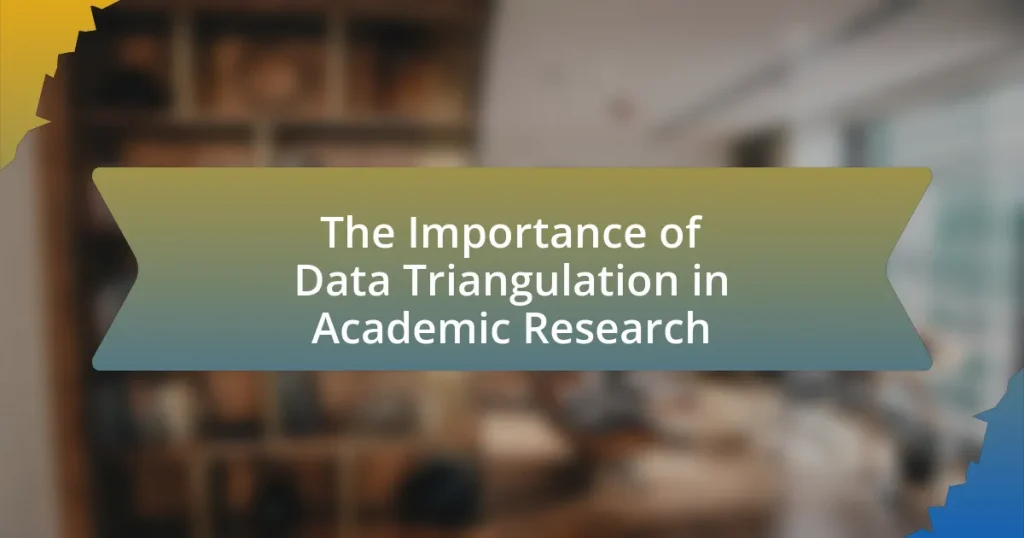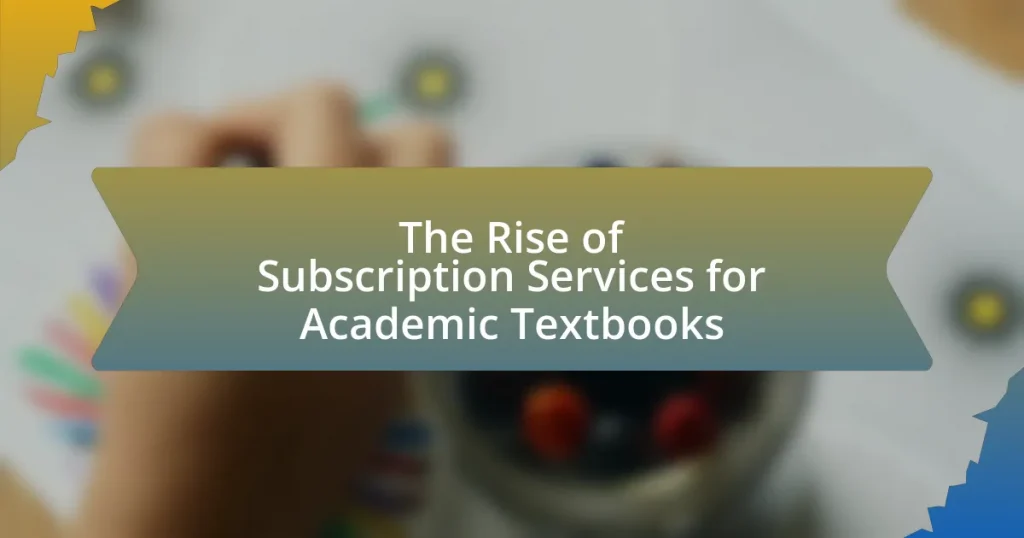Data triangulation is a methodological approach in academic research that involves using multiple data sources or methods to enhance the validity and reliability of findings. This article outlines the significance of data triangulation, highlighting its role in reducing bias and providing a comprehensive understanding of research topics. Key principles include methodological, data source, and investigator triangulation, each contributing to more robust research outcomes. The article also discusses the steps for implementing data triangulation, common challenges faced by researchers, and best practices to ensure effective application, ultimately emphasizing how triangulation improves research credibility and outcomes.

What is Data Triangulation in Academic Research?
Data triangulation in academic research refers to the use of multiple data sources or methods to study a phenomenon, enhancing the validity and reliability of research findings. This approach allows researchers to cross-verify results, reducing the potential for bias and providing a more comprehensive understanding of the research topic. For instance, combining qualitative interviews with quantitative surveys can yield richer insights, as demonstrated in studies like “Triangulation in Qualitative Research” by Denzin, which emphasizes the importance of diverse perspectives in data collection.
Why is Data Triangulation important in research?
Data triangulation is important in research because it enhances the validity and reliability of findings by integrating multiple data sources. By employing various methods, such as qualitative interviews, quantitative surveys, and observational data, researchers can cross-verify results, reducing the risk of bias and increasing the robustness of conclusions. For instance, a study published in the “Journal of Mixed Methods Research” demonstrates that triangulation can lead to more comprehensive insights, as it allows for a fuller understanding of complex phenomena by capturing different perspectives. This methodological diversity not only strengthens the evidence base but also fosters a more nuanced interpretation of data, ultimately contributing to more credible and actionable research outcomes.
What are the key principles of Data Triangulation?
The key principles of Data Triangulation include the use of multiple data sources, methods, and perspectives to enhance the validity and reliability of research findings. By integrating qualitative and quantitative data, researchers can cross-verify results, reducing bias and increasing the robustness of conclusions. For instance, a study may combine surveys, interviews, and observational data to provide a comprehensive understanding of a phenomenon. This approach is supported by the notion that diverse data sources can illuminate different aspects of a research question, leading to more nuanced insights and stronger evidence.
How does Data Triangulation enhance research validity?
Data triangulation enhances research validity by integrating multiple data sources to corroborate findings. This approach reduces bias and increases the reliability of results, as it allows researchers to cross-verify information from different perspectives. For instance, a study that combines qualitative interviews, quantitative surveys, and observational data can provide a more comprehensive understanding of a phenomenon, thereby strengthening the overall conclusions drawn. Research has shown that using diverse data sources can lead to more robust and credible outcomes, as evidenced by a meta-analysis published in the Journal of Mixed Methods Research, which highlights that triangulation significantly improves the trustworthiness of qualitative research findings.
What types of Data Triangulation exist?
There are three main types of data triangulation: methodological triangulation, data source triangulation, and investigator triangulation. Methodological triangulation involves using multiple methods to collect data, such as combining qualitative and quantitative approaches to enhance the validity of research findings. Data source triangulation refers to gathering data from different sources or populations to ensure a comprehensive understanding of the research topic. Investigator triangulation entails involving multiple researchers in the data collection and analysis process to minimize bias and increase reliability. Each type contributes to a more robust and credible research outcome by addressing potential limitations inherent in single-method or single-source studies.
How does methodological triangulation differ from data triangulation?
Methodological triangulation involves using multiple research methods to study a phenomenon, while data triangulation refers to using different data sources to validate findings. Methodological triangulation enhances the robustness of research by integrating qualitative and quantitative approaches, thereby providing a more comprehensive understanding of the subject. In contrast, data triangulation strengthens the credibility of results by cross-verifying information from various datasets, which can help mitigate biases inherent in a single source. Both approaches are essential in academic research, but they serve distinct purposes in enhancing validity and reliability.
What is investigator triangulation and its significance?
Investigator triangulation is a qualitative research method that involves using multiple researchers to collect and analyze data, enhancing the credibility and validity of the findings. This approach mitigates individual biases and perspectives, allowing for a more comprehensive understanding of the research subject. The significance of investigator triangulation lies in its ability to produce richer, more nuanced insights, as diverse viewpoints contribute to a more robust interpretation of data. Research indicates that studies employing investigator triangulation often yield more reliable results, as evidenced by a systematic review published in the Journal of Mixed Methods Research, which highlights the effectiveness of this method in improving research quality and trustworthiness.

How is Data Triangulation applied in academic research?
Data triangulation is applied in academic research by integrating multiple data sources to enhance the validity and reliability of findings. Researchers utilize various methods such as surveys, interviews, and observational data to cross-verify results, thereby reducing bias and increasing the robustness of conclusions. For instance, a study by Denzin (1978) emphasizes that combining qualitative and quantitative data allows for a more comprehensive understanding of research questions, leading to more credible outcomes. This approach is particularly effective in fields like social sciences, where complex phenomena require diverse perspectives for accurate interpretation.
What are the steps involved in implementing Data Triangulation?
The steps involved in implementing Data Triangulation include defining the research question, selecting multiple data sources, collecting data from these sources, analyzing the data, and integrating the findings to draw comprehensive conclusions. Defining the research question establishes the focus of the study, while selecting multiple data sources ensures a diverse perspective. Collecting data from these sources involves gathering qualitative and quantitative information, which is then analyzed to identify patterns and discrepancies. Finally, integrating the findings allows researchers to validate results and enhance the reliability of their conclusions, thereby strengthening the overall research quality.
How do researchers select appropriate data sources for triangulation?
Researchers select appropriate data sources for triangulation by evaluating the relevance, credibility, and diversity of the data. They prioritize sources that provide complementary perspectives, ensuring that the data can corroborate findings across different methodologies. For instance, a study may incorporate qualitative interviews alongside quantitative surveys to enhance the robustness of the results. This approach is supported by the principle that using varied data sources can mitigate biases and improve the validity of research conclusions, as demonstrated in the work of Denzin (1978), who emphasized the necessity of multiple methods to achieve a comprehensive understanding of a phenomenon.
What methods are commonly used in Data Triangulation?
Data triangulation commonly employs methods such as using multiple data sources, employing different data collection techniques, and integrating various theoretical perspectives. These methods enhance the validity and reliability of research findings by cross-verifying data from diverse origins, such as qualitative interviews, quantitative surveys, and existing literature. For instance, a study by Denzin (1978) emphasizes that combining qualitative and quantitative approaches can provide a more comprehensive understanding of research questions, thereby reinforcing the credibility of the results.
What challenges do researchers face with Data Triangulation?
Researchers face several challenges with data triangulation, primarily related to the integration of diverse data sources. One significant challenge is ensuring the compatibility of data collected from different methods, such as qualitative interviews and quantitative surveys, which can lead to inconsistencies in findings. Additionally, researchers often encounter difficulties in managing the increased complexity of analyzing multiple data sets, which can complicate the interpretation of results. A study by Denzin (1978) highlights that the potential for bias increases when researchers must reconcile differing perspectives from various data sources, making it essential to maintain rigorous methodological standards. Furthermore, logistical issues, such as time constraints and resource allocation, can hinder the effective implementation of triangulation strategies.
How can researchers overcome biases in Data Triangulation?
Researchers can overcome biases in Data Triangulation by employing multiple data sources, methods, and perspectives to validate findings. This approach minimizes the influence of any single source or method, thereby enhancing the reliability of the results. For instance, using qualitative and quantitative data together can provide a more comprehensive understanding of the research question, as demonstrated in studies like “Triangulation in Research: A Review” by Denzin, which emphasizes the importance of diverse methodologies in reducing bias. By systematically integrating various data types, researchers can achieve a more balanced and accurate representation of the phenomena under investigation.
What are the limitations of Data Triangulation in research?
Data triangulation in research has several limitations, including potential bias in data sources, the complexity of integrating diverse data types, and the possibility of conflicting results. Bias can arise when researchers select data sources that align with their preconceived notions, leading to skewed interpretations. The integration of qualitative and quantitative data can be challenging, as differing methodologies may complicate the synthesis of findings. Additionally, conflicting results from various data sources can create confusion and undermine the validity of conclusions drawn from the research. These limitations highlight the need for careful consideration and methodological rigor when employing data triangulation in academic research.

What are the benefits of using Data Triangulation in academic research?
Data triangulation enhances the validity and reliability of academic research by integrating multiple data sources, methods, or perspectives. This approach mitigates biases inherent in any single method, providing a more comprehensive understanding of the research problem. For instance, a study by Denzin (1978) emphasizes that triangulation can lead to richer data and more robust conclusions, as it allows researchers to cross-verify findings and identify inconsistencies. Additionally, using diverse data sources can reveal different facets of a phenomenon, ultimately leading to more nuanced insights and stronger theoretical frameworks.
How does Data Triangulation improve research outcomes?
Data triangulation improves research outcomes by enhancing the validity and reliability of findings through the integration of multiple data sources. By combining qualitative and quantitative data, researchers can cross-verify results, reducing biases and increasing the robustness of conclusions. For instance, a study published in the “Journal of Mixed Methods Research” by Creswell and Plano Clark (2011) demonstrated that using diverse data sources led to more comprehensive insights and a deeper understanding of complex phenomena. This methodological approach not only strengthens the evidence base but also provides a more nuanced perspective, ultimately leading to more credible and actionable research outcomes.
What impact does Data Triangulation have on research credibility?
Data triangulation significantly enhances research credibility by providing multiple perspectives and sources of data, which helps to validate findings. When researchers utilize various methods, such as qualitative interviews, quantitative surveys, and observational studies, they can cross-verify results, reducing the likelihood of bias and increasing the robustness of conclusions. For instance, a study published in the “Journal of Mixed Methods Research” by Creswell and Plano Clark (2011) demonstrates that employing diverse data sources leads to more reliable and comprehensive insights, thereby strengthening the overall trustworthiness of the research.
How does Data Triangulation contribute to comprehensive understanding?
Data triangulation enhances comprehensive understanding by integrating multiple data sources to provide a more holistic view of a research problem. This method reduces bias and increases the validity of findings, as it allows researchers to cross-verify information from different perspectives. For instance, a study published in the “Journal of Mixed Methods Research” by Creswell and Plano Clark (2011) demonstrates that combining qualitative and quantitative data leads to richer insights and more robust conclusions. By employing data triangulation, researchers can identify patterns and discrepancies that may not be evident when relying on a single data source, ultimately leading to a deeper and more nuanced understanding of the subject matter.
What best practices should researchers follow for effective Data Triangulation?
Researchers should follow several best practices for effective data triangulation, including using multiple data sources, employing various methods of data collection, and integrating different theoretical perspectives. Utilizing multiple data sources enhances the validity of findings by providing a more comprehensive view of the research question. For instance, combining qualitative interviews with quantitative surveys can reveal deeper insights and corroborate results. Employing diverse methods, such as case studies, experiments, and observational studies, allows researchers to cross-verify data and reduce bias. Integrating different theoretical perspectives can also enrich the analysis, as it encourages researchers to consider alternative explanations and frameworks. These practices collectively strengthen the reliability and credibility of research outcomes, as supported by studies highlighting the importance of methodological diversity in enhancing research robustness.
How can researchers ensure the reliability of their triangulated data?
Researchers can ensure the reliability of their triangulated data by systematically combining multiple data sources, methods, or perspectives to cross-verify findings. This approach enhances the validity of the results, as corroborating evidence from different angles reduces the likelihood of bias or error. For instance, a study by Denzin (1978) emphasizes that using qualitative and quantitative methods together can provide a more comprehensive understanding of the research problem, thereby increasing the reliability of the conclusions drawn. Additionally, maintaining consistent data collection procedures and employing rigorous analytical techniques further strengthens the reliability of triangulated data.
What strategies can enhance the effectiveness of Data Triangulation?
To enhance the effectiveness of data triangulation, researchers should employ multiple data sources, methods, and theoretical perspectives. Utilizing diverse data sources, such as qualitative interviews, surveys, and observational data, allows for a more comprehensive understanding of the research problem. Incorporating various methods, like qualitative and quantitative approaches, can validate findings through cross-verification. Additionally, applying different theoretical frameworks can provide multiple lenses through which to interpret the data, enriching the analysis. Research has shown that these strategies lead to more robust and credible results, as evidenced by studies demonstrating that triangulation increases the reliability and validity of research outcomes.















